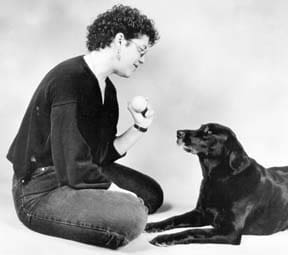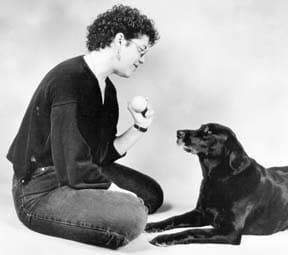Yesterday, we lost our dearest friend, Emmett. He was 13 and everyone loved him. He was kind and patient – you know, the strong, silent type. Gracie, his sister and a beagle “bon vivant,” just ADORED him. She would use him for a pillow, a step stool, a cuddle buddy, and her all-around favorite fella. They would play for hours in the back yard and even though he was an old man, he could really wear Grace to a frazzle. She has figured out that he won’t be coming back. She mopes, she sighs, and she tries to get her other dog-sister to play with her, but Annie (the sister) just isn’t the touchy-feely type. Annie is mourning in her own way as well. She cannot let me out of her sight. She’s fine as long as she can get to me, but let me turn the corner or go outside and leave her in, and she yelps at ear-splitting levels.
My question: What resources are out there for dogs experiencing grief? How do I help my “kids” and myself make the transition to an Emmett-less life? He was such a big part of this little family (and at 90 pounds, in more ways than one) and his absence has left a great hole in our hearts and our dog beds. From asking my “doggy” human friends, this seems to be a question that comes up any time we lose one of our “clan” and I haven’t been able to find any really good information that I can truly use.
-Anita Vreeland

Tulsa, OK
We asked Dr. Carolyn Blakey, a veterinarian for 31 years, to answer this question. Dr. Blakey’s practice, the Westside Animal Clinic, is located in Richmond, Indiana. (Dr. Blakey can be reached at 765-966-0015.)
For problems that are based on emotion, I don’t think there is anything more helpful than using flower essence remedies. They work especially well on animals, which is plain to see, because of the lack of a placebo effect with animals.
Flower remedies were originally developed by an English physician, Edward Bach, in the early 1900s, and are used primarily for correcting emotional imbalances. Bach formulated 38 remedies, each for a different and specific emotional issue, although many more have been formulated since then by other practitioners.
Flower remedies are made by soaking freshly picked flower blossoms of various kinds in pure water; then the strained liquid is preserved with alcohol, usually brandy. Several drops are given to the animal (or person), as many times a day as needed. The liquid can be placed directly in the dog’s mouth, or diluted with some pure water and sprayed all around the animal with a fine misting bottle. It can also be applied topically; some practitioners like to dab the liquid on the animal’s face and ears, and on the bare skin on its tummy and inner thighs.
The best-known brand is the original one, the Bach Flower Essences, but they are all wonderful. Most health food stores carry at least one line of flower essences, and sometimes more. Most places that sell the flower essences also carry books or booklets on how to use the essences. Bookstores that have large “New Age” sections would also carry books that could tell you which remedies are indicated in which situations. There are also flower essence practitioners who can recommend which ones to give your dogs. However, I’ve found that most owners can do just as good a job of reading the descriptions and knowing which would be best for their own dogs. All dogs are individuals; as you described, both of your dogs are expressing their grief differently.
In your case, the first one I would probably give to both of your dogs is Star of Bethlehem, indicated for grief, trauma, and/or loss. Others might include Gorse, “for hopelessness where there is little hope of relief;” mustard, for gloom; olive, for “mental and physical exhaustion from illness or personal ordeal;” walnut, which helps stabilize emotional upset during transition periods; and willow, which is for someone who feels they must suffer unfairly. However, you know your dogs best; find one of the little booklets and read all about the original 38 remedies in order to select the best ones for your dogs.
You can also start off with Rescue Remedy. This remedy has five different flower essences mixed together in it, including Star of Bethlehem, rock rose (for fear and panic), impatiens (for tension and mental agitation), cherry plum (for loss of emotional control), and clematis (for lack of interest in the present). I think Rescue Remedy should be administered every time there is stress, mental or physical. I carry it with me everywhere I go, to give to people, animals, or myself!
———-
Fatty Tumors
Our eight-year-old spayed female Doberman has several non-cancerous fatty tumors. We are thinking of changing her name to “Lumpy.” Most of the tumors are small; less than half a walnut size. One of the tumors is large; more like half of a lemon. This large one has grown another inch in diameter in the last three months.
Our veterinarian recently told us that because of the size of the tumor and the increase of vascularization needed to feed this tumor that surgery should be done soon. Are there any other treatments I could try before having the tumor removed?
-Mark Valery
Billerica, MA
We turned this question over to Dr. Charles Loops, a well-known holistic veterinarian in Pittsboro, North Carolina. Dr. Loops practices homeopathy exclusively, and consults with many of his clients over the telephone. He has a special interest in cancer treatment. (Dr. Loops can be reached at 919-542-0442.)
Fatty tumors or lipomas are benign, non-cancerous growths that occur on many aging animals including dogs, cats and people. The only problem that may develop from these fatty deposits is that occasionally they are located in places that impede or interfere with movement. It sounds as though this may be the case with your female Doberman. A large lipoma forming on the rib cage directly behind the front leg seems to be fairly common with this breed and often requires surgical removal if movement of the leg is affected. This surgery can be traumatic as it involves a large area and because of so much fatty infiltration, occasional post-surgical problems can occur necessitating a drain being left in place to accommodate fluid buildup. An eventual positive outcome should be expected, however.
I have seen good results, about 50 percent of the time, with homeopathic treatment of small lipomas. I have not seen the large variety disappear with holistic treatment of any type, although they should respond to correct constitutional prescribing whether homeopathic or by acupuncture. This may be something you might explore by contacting a holistic practitioner, but surgery will most likely be the choice if this tumor begins to limit her range of motion or use of this leg.
———-
Aggression With Other Dogs
We can’t take our 12-year-old Golden Retriever anywhere there may be other dogs without creating a scene. Phoebe becomes enraged when she sees other dogs and tries to attack them. We’re curious about what an animal communicator might be able to tell us about Phoebie’s past (we adopted her from a shelter at four) and what we can do about her behavior.
We put Phoebe’s family in touch with Rafaela Pope, a telepathic animal communicator. Pope’s work has been featured on radio, TV, and the print media. Pope lives in Davis, California, and can be reached at 530-758-6111.
My first impression of Phoebe is as a sweet, gentle sort of soul, but with a definite vigorous edge to her. I explained who I was, and told Phoebe that her family was very concerned about her tendency to attack other dogs. Could she tell me why she did that?
Phoebe replied, “I don’t want them (other dogs) around my family. I had to work really hard to get my family and I don’t want other dogs around them.” “What do you mean, you had to work hard to get your family?” I asked. “When I was in the animal shelter, I had to be nice, cute, appealing. Many people turned me down. So now I am glad to have my family. I don’t want them to get another dog.” I asked her what she thought would help. Phoebe promptly responded, “Have the other dogs give me treats!”
When I puzzled over this odd comment with Phoebe’s owner, she told me that she had given Phoebe treats in a recent training session when Phoebe had approached another dog without attacking. I think Phoebe had gotten the impression that the treats were an offering from the other dog, and it seemed like a good idea to her!
Phoebe’s owner also informed me that the family had discussed getting another dog, but because of Phoebe’s extreme reactions, they wouldn’t seriously consider another dog until after Phoebe dies. In this situation, that’s probably a good idea.






